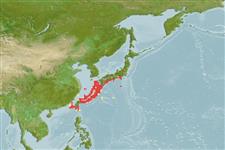>
Gadiformes (Cods) >
Macrouridae (Grenadiers or rattails)
Etymology: Coelorinchus: Greek, koilos = a hollow + Greek, rhyngchos = jaw (Ref. 45335).
Eponymy: Kamakichi Kishinouye (1867–1929) was a fisheries biologist at Tokyo Imperial University, where he was a professor in the Faculty of Agriculture. [...] (Ref. 128868), visit book page.
More on authors: Jordan & Snyder.
Environment: milieu / climate zone / intervalo de profundidade / distribution range
Ecologia
marinhas batidemersal; não migratória; intervalo de profundidade 200 - 600 m (Ref. 95664). Deep-water; 8°C - 12°C (Ref. 1371); 35°N - 28°N, 126°E - 139°E (Ref. 1371)
Western Pacific: South China Sea, off Taiwan to Japan.
Tamanho / Peso / Idade
Maturidade: Lm ? range ? - ? cm
Max length : 36.0 cm TL macho/indeterminado; (Ref. 1371)
Espinhos dorsais (total) : 2; Espinhos anais: 0. Snout slightly long and pointed, with broad triangular naked areas on the dorsal surface; the terminal scute small, poorly defined in larger individuals. Overall color is light brown with a large ocellated black blotch above and behind the pectoral fin bases; a fainter saddle just below the anterior end of the second dorsal fin extending 2 to 3 rows below the lateral line. The mouth cavity whitish; the gill cavity blackish; the fins generally dusky except for the blackish pelvic fins.
Body shape (shape guide): elongated; Cross section: circular.
Captured at depths from 200 to more than 600 m (Ref. 95664). Feeds primarily on polychaetes with crustaceans of minor importance (Ref. 1371).
Life cycle and mating behavior
Maturidade | Reprodução | Desova | Ovos | Fecundidade | Larvas
Cohen, D.M., T. Inada, T. Iwamoto and N. Scialabba, 1990. FAO species catalogue. Vol. 10. Gadiform fishes of the world (Order Gadiformes). An annotated and illustrated catalogue of cods, hakes, grenadiers and other gadiform fishes known to date. FAO Fish. Synop. 125(10). Rome: FAO. 442 p. (Ref. 1371)
Categoria na Lista Vermelha da IUCN (Ref. 130435: Version 2025-1)
Ameaça para o homem
Harmless
Utilização humana
Pescarias: pouco comercial
Ferramentas
Relatórios especiais
Descarregue XML
Fontes da internet
Estimates based on models
Preferred temperature (Ref.
123201): 10.3 - 16.2, mean 14.1 °C (based on 10 cells).
Phylogenetic diversity index (Ref.
82804): PD
50 = 0.5000 [Uniqueness, from 0.5 = low to 2.0 = high].
Bayesian length-weight: a=0.00245 (0.00126 - 0.00477), b=3.19 (3.02 - 3.36), in cm total length, based on LWR estimates for this Genus-body shape (Ref.
93245).
Nível Trófico (Ref.
69278): 3.3 ±0.40 se; based on food items.
Resiliência (Ref.
120179): Baixo, tempo mínimo de duplicação da população 4,5 - 14 anos (Preliminary K or Fecundity.).
Fishing Vulnerability (Ref.
59153): Low to moderate vulnerability (26 of 100).
🛈
